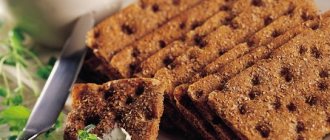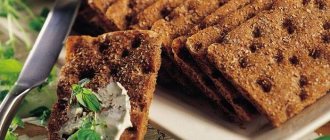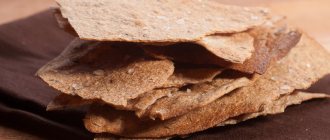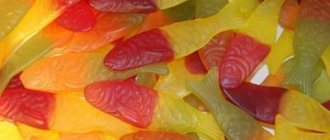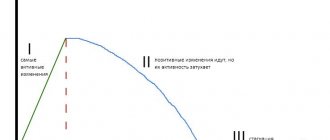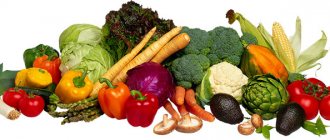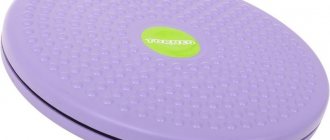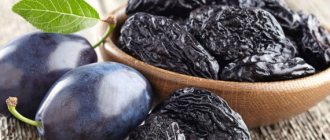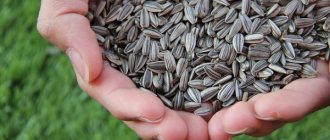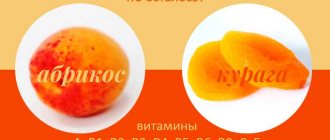Article on the topic
Crispbread is a dietary product. Is it true?
If you want to always stay healthy and slim, stop eating white loaves and rolls made from premium flour and switch to bread products richer in fiber, vitamins and microelements: whole grain loaves, with bran and crispbread. The latter should not be consumed only by children under 2-3 years of age (their young bodies are not yet adapted to such coarse food), but adults can easily make sandwiches from them with low-fat cottage cheese, cheese and vegetables, put low-calorie pates on dry slices and create light ones from them. desserts with fruit. Just don’t think that all bread is equally healthy. There are wonderful crisps made only from whole grains of wheat or corn, and there are examples that do not differ in composition from white bread, and are even supplied with a fair amount of artificial food additives.
Who blew up the wheat?
Whole grain breads made in a machine called an “extruder” are considered the healthiest. They are easy to recognize by their appearance: they look like briquettes (usually round), consisting of swollen grains tightly stuck together. The manufacturing technology of such a product is such that the manufacturer simply cannot put anything harmful to your figure into it: neither fat, nor starch, nor yeast, nor sugar, nor preservatives with dyes. Extruded bread contains only grains and cereals: wheat, rice, buckwheat, corn, pearl barley (unfortunately, they cannot be made from rye). First, the grain mixture is prepared, then it is soaked for half an hour to 12 hours (corn swells for almost a day) so that the rough shells soften a little. Then the grains are poured into the extruder and kept there for 8 seconds at very high pressure and temperature from + 260º C to + 300º C. Under such conditions, the water trapped under the shell instantly turns into steam, and it turns the grain out. In essence, what we get is popcorn, which is familiar to us, but since the grains are in a limited space and have nowhere to grow, after the “explosion” they stick together and form a dense briquette. By the way, these are the breads that are most popular in Europe. Firstly, they have an ideal composition (only wheat, buckwheat, corn, etc.), and secondly, during an incredibly short baking period, the beneficial substances of grains and cereals are preserved in maximum quantities.
Application
Before you buy such a loaf of bread in a store, carefully study its composition - this will determine what type of loaf of bread you should choose. In addition to the composition, it is worth looking at the uniformity of consistency and uniformity of color. The product should be baked evenly on all sides, not crumble when cut, and be crispy when bitten.
To ensure that your diet is truly balanced, it is advisable to consult a nutritionist before switching to this type of product. Doctors usually recommend starting to introduce bread gradually. First, use them once a day, and then completely replace regular bread with them.
The crispbreads are delicious on their own and are also great for making toast, sandwiches, sandwiches, and even sweet tartines.
Market Analytics
- Global cosmetics market 2021: an unprecedented test for the global cosmetics industry
- Top 10 Cosmetic Research and Development of 2021
- 2020 in the beauty industry – innovation without borders
Convenient search for beauty salons on our website
Beauty salons in Moscow Beauty salons in St. Petersburg Beauty salons in Ekaterinburg Beauty salons in Novosibirsk
Latest blog posts on our website
- Naturecream / Properties of the “Sunny” oil itself
- Naturecream / “Sugar” wrinkles - or what glycation can do
- Naturecream / Esterified oils
- Naturecream / Arnica - the magical plant of alchemists
- Naturecream / Tremella Extract - Snow Mushroom Detox for Skin
- Prostye-sovety / How to visually enlarge your lips with makeup
- Naturecream / Apricot kernel oil for face
- Naturecream / MATRIXYL3000 - the best skin elasticity stimulator
- Naturecream / SPF in Natural Oils
- Naturecream / Geranium (Pelargonium) oil for skin health and beauty
Latest forum topics on our website
- Natalya / How to properly make a gelatin mask?
- Mrs._Smith / Badly sunburned! What to do?((
- Ice / Is it necessary to combine fitness classes with a diet?
- Antonova / What can be used for hair loss?
- Radio operatorKat / Who was on a protein diet?
Other articles in this section
| Bread with bran At first, bran was considered suitable only for animal feed; it was steamed and fed to animals for faster weight gain. Thanks to the research work carried out, it was revealed how useful bread with bran obtained after grain processing is. A large number of people know that bran is the husk peeled from grain, but only a few people know why it is useful. It is interesting to know that this is where the largest amount of biologically valuable substances is concentrated - about 90%. |
| Shangi Many, mistakenly, believe that this is an original Russian dish. In fact, the name is borrowed from the language of the Finnish tribes, who lived together with the Slavic peoples in the Russian North. Around the 17th century, according to references found in chronicles, “shangas” began to spread from Karelia to the Ob and to Western Siberia. This culinary product has been preserved in its original form in the cuisine of the peoples of the Trans-Urals and Middle Urals; it is little known in Western Russia. |
| Matzo Matzo is one of the most legendary and ancient types of bread. Jews first began to make it, so this product is associated with this people. Matzo is considered "poor bread." |
| English grain bread Grain bread differs from ordinary bread not only in composition, but also in the method of preparation. In order to bake English grain bread, first of all, you need to have the following products: wheat grain, water, yeast, flour, butter, salt. You can change the composition to your taste, add honey, milk or other ingredients to the recipe. |
| Oatmeal Bread The first mention of oat cakes was recorded in English chronicles in 779. For a long time, oatmeal was the hallmark of the British Isles, and oat bread was a staple in the diet of most Englishmen. Today there are many products that use oats, and one of the most delicious and widespread is oat bread. |
| Baguette A French baguette is a very long loaf of bread. The world's first baguette was made in France in 1920. At that point, the government passed a law that bakeries were not supposed to make bread until four in the morning. This made it difficult for the bakers working in the bakery. The fact is that the fresh buns simply did not have time to get ready for opening. After all, first you had to knead the dough, then wait for it to rise, and then just form the buns and put them in the oven. Then the bakers had an idea - they came up with a new recipe, according to which they began to bake a bun. The dough mixed according to this recipe rose very quickly, and this product was baked for only a quarter of an hour. This gave the bakers time to have the hot buns ready just before the bakery opened. |
| Ukrainian bread In Ukraine, as well as in Russia, bread is the most important product. Almost no meal is complete without it. Without bread, even the most satisfying dish seems incomplete. And Ukrainian bread is a wonderful, balanced product, rich in a wide variety of nutrients. |
| Old Russian grain bread In Rus', bread has always been the center of everything. This meant that bread was a sign of hospitality, friendship and peace in the home. |
| Garlic bread Bread is the head of everything. This saying carries great semantic meaning, because this product has more than once saved people from starvation. Today, bread and bakery products remain the most important products of humanity. |
| Focaccia The classic national wheat flatbread in Italy is called focaccia - “bread baked in the hearth (or in ash).” She was also nicknamed the progenitor of pizza because of her great similarity. In ancient times, focaccia was the food of warriors and peasants. Modern focaccia can be spicy, salty and even sweet. The shape of focaccia is traditionally round, but it can also be rectangular or triangular. |
Bread, but dry
If the bread you have chosen does not consist of clearly visible whole grains, but is crispy thin croutons, then they are a baked product and are prepared in the same way as regular bread. First, the dough is kneaded from flour, water, yeast, milk powder and spices, then it is infused, then rolled out into layers and baked. The technology and composition of the ingredients of baked bread allows you to put anything in them, so you should be very careful when choosing this type of product. Let’s say, if the manufacturer used premium flour devoid of vitamins and fiber, did not spare yeast for fluffiness, fat, sugar, salt, antioxidants coded “E” and preservatives for greater preservation, such crisps cannot be called healthy, they will give you unnecessary fast carbohydrates and will differ from a white loaf only in less moisture.
To avoid accidentally purchasing harmful ones instead of super-healthy baked breads, be sure to read their ingredients on the label. Ideal dietary specimens should be made from whole grain or wholemeal flour, without yeast (only baking soda is possible), preferably with the addition of seeds (flax, sunflower, sesame) and, of course, without the presence of modified starch, preservatives, dyes, antioxidants and other additives. Proper bread can only be natural, otherwise they cannot be classified as healthy products.
Brittle and crunchy
Some people like Borodino bread with coriander, others prefer rye bread with dill, and still others choose whole grain “exploded” ones. Fortunately, the range of healthy snacks today is huge. But no matter what type of crisps you choose, pay attention to their quality. According to technologists, ideal breads cannot be soft, moist or, conversely, too “woody” (otherwise they will pose a threat to the integrity of the teeth). They should be dry, brittle, crispy, well cooked and easy to bite. The edges of the correct specimens are smooth, not crumbling, the color is uniform: it’s bad when it’s light in one place and dark brown in another. The surface of baked bread may be rough, and “exploded” ones may have small voids due to the proximity of grains of different diameters, but there should not be too many of them.
At what age can bread be given to children?
Despite the fact that the benefits of bread for the body are great and their harm is minimal, experts recommend giving snacks to children after three years of age. In this case, the daily norm should include no more than 2 - 3 pieces. The product contains coarse fibers that are difficult for a fragile child's stomach to digest, which is why it is strictly forbidden to give the product to very young children: they can lead to stool problems, bloating, and pain in the stomach.
Before introducing bread into your diet, you need to check if your child is allergic to them. You should give your baby a small piece of the briquette and monitor his reaction throughout the day. If no changes are observed, you can give the product, but in minimal quantities.
Attention! If any symptoms indicating an allergy appear, your baby should stop eating bread and consult a doctor.
Packaging defects
When choosing bread rolls, pay attention to the integrity of the packaging they are in: the box should not be wrinkled, the bag should not be torn. If there is a defect, it means that the product could become damp and moldy or, conversely, dry out. Of course, it’s not for nothing that bread got the nickname “canned bread” - they have a very long shelf life, but they can also go bad. Briquettes made from “exploded” grains are stored the longest. They contain a minimum of moisture and fat (only natural fat, contained in seeds and cereals), they do not go rancid and “live” up to 18 months. Baked goods contain vegetable oil, flour and additives, so they have a shorter shelf life of 6-10 months.
Expert opinion
Alexandra Romanova, leading innovation specialist for the Healthy Nutrition product line of Khlebprom OJSC The calorie content of bread is about 300 kcal. This is almost the same as bread, because these products are made from the same raw materials - grain, which has a certain energy content. True, bread rolls are carriers of “long-lasting” carbohydrates - they are easily absorbed by the body and at the same time give a feeling of fullness. In addition, they are rich in fiber. And it interferes with the absorption of calories. That is, by consuming 35 g of fiber per day, you burn 245 kcal. If you want to lose weight, eat no more than 3-5 breads and combine them with low-fat cottage cheese, cheese, herbs, vegetables and berries.
What are the benefits of breads?
Despite the fact that only improper use of the product can cause harm, the benefits of crispbread are multifaceted. They fill the body with energy, which is so necessary when losing weight.
In addition, introducing them into the diet helps normalize the functioning of internal organs and the functioning of body systems.
Properties of dry bread:
- normalize the functions of the central nervous system;
- strengthen the immune system;
- fatty acids in snacks improve memory, attention and brain activity in general;
- normalize blood pressure;
- reduce sugar and cholesterol;
- improve the functioning of the circulatory and cardiovascular systems;
- help cope with hormonal imbalances;
- are a preventive measure for diseases of the genitourinary system and digestive tract.
When consuming cereal briquettes and biscuits with their beneficial qualities and preventive properties while losing weight, it is recommended to exclude bread from your diet.

